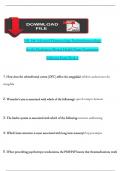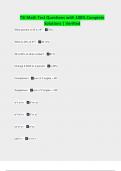NR 546 Advanced Pharmacology Psychopharmacology
for the Psychiatric-Mental Health Nurse Practitioner
Midterm Exam Week 4
1. How does the orbitofrontal cortex (OFC) affect the amygdala?: inhibits andactivates the
amygdala
2. Wernicke's area is associated with which of the following?: speech compre-hension
3. The limbic system is associated with which of the following: emotion andlearning
4. Which brain structure is most associated with long term memory?: hip-pocampus
5. When prescribing psychotropic medications, the PMHNP knows that thesemedications work
,within which specific areas?: mood
6. Which of the following are involved in regulating neurotransmission via ex- citation-secretion
coupling?: voltage-sensitive sodium channels and voltage-sen-sitive calcium channels
7. What system influences the length of time for a drug to achieve efficacy?: -
signal transduction cascades
8. One of the signal transduction cascades, pass the message from a firstreceptor to a second
messenger.: G protein linked systems
9. Human central nervous system communication at synapses is which of thefollowing?: chemical
10. Which of the following is an excitatory neurotransmitter?: glutamate
11. Which statement correctly pairs the pharmacodynamic effect with its defi-nition?: antagonist
effect - drug binds to receptor, but does not activate a response
,12. A major current hypothesis for the cause of schizophrenia proposes thatN-methyl-d-aspartate
(NMDA) receptors may be which of the following? Correct!: hypofunctional
13. Which medication is least associated with weight gain?: aripiprazole
14. Which dopamine pathway is associated with positive symptoms of schiz-ophrenia?: mesolimbic
pathway
15. Which pathway is associated with negative symptoms?: The mesocorticalpathway
16. Is part of the extrapyramidal nervous system and associated with ex-trapyramidal
symptoms (EPS): nigrostriatal pathway
17. This pathway is associated with hyperprolactinemia.: The tuberoinfundibu-lar pathway
18. A 34-year old male recently began experiencing breast secretions while receiving risperidone .
Which dopamine pathway is associated with this sideeffect?: tuberoinfundibular pathway
19. A 44-year-old woman is initiated on an atypical antipsychotic for the treatment of
schizophrenia. Regarding affinity, atypical antipsychotics demon-
,strate which of the following most often?: Atypical antipsychotics have equalpositive symptom
antipsychotic actions and low extrapyramidal symptoms.
20. is a syndrome that can be associated with several different psychiatric disorders. Symptoms
include hallucinations, delusions, disorganized speech,disorganized behavior, and distortions of
reality. This syndrome can affect a person's cognition, affective response, communication, capacity to
recognizereality, and ability to relate to others.: psychosis
21. What Diagnosis require the presence of psychosis?: schizophreniasubstance-induced
psychotic disorders
schizophreniform disorder
schizoaffecive disorder
delusional disorder
brief psychotic disorder
psychotic disorder due to a medical condition
22. What diagnosis has a diagnosis of psychosis as a feature?: maniadepression
cognitive disorders
dementia
23. What are some positive symptoms?: HallucinationsDelusions
Thought disorder
Hostility
,Excitability
24. What are some Negative symptoms?: Affective flatteningAlogia
Anhedonia
Amotivation
Asociality
25. What area of the brain is associated with negative and affective symp-toms?: Mesocortical
and ventromedial prefrontal cortex:
26. What area of the brain is associated with cognitive symptoms?: Dorsolat-eral
27. What area of the brain is associated with aggressive, impulsive symp-toms?: Orbitofrontal
and connections to the amygdala
28. Non-selectively blocks dopamine D2 receptors, specifically in mesolimbicpathway. Improves
Positive Symptoms
Use: Acute & Chronic Schizophrenia & Psychosis: First generation antipsy-chotics
, 29. are associated with movement, intelligence, abstract thinking, the ability toorganize, personality,
behavior, and emotional control.Traumatic brain injuriescan result in personality changes, difficulty
controlling emotions, and other cognitive functions: Frontal Lobes
30. responsible for proprioception, is the home of the somatic senses. This part of the brain helps a
person to identify spatial relationships, interpret painand touch in the body, and identify and give
meaning to objects: Parietal Lobe(Middle Brain)
31. Damage to the anterior portion may cause asterogenesis, the loss of abilityto recognize objects via
the sense of touch. This may be experienced by patients with post cerebral vascular accidents:
parietal Lobe
32. and involved in short-term memory, speech, auditory signals, and smell recognition. It
identifies "what" things are - object identification. It contains the limbic system, amygdala, and
hippocampus.: Temporal Lobe
33. Disorders from this lobe include dementia, affective disorders, and atten- tion deficit
hyperactivity disorders (ADHD).: Temporal Lobe
34. controls visual processing. Damage to this lobe results in the inabilityto form visual
memories. Bilateral lobe damage results in the inability to recognize items by sight even though
vision is normal.: Occipital Lobe
35. This separates the frontal lobe from the parietal lobe.: Central sulcus
36. This controls the communication between the two brain hemispheres. Isinvolved in attention,





